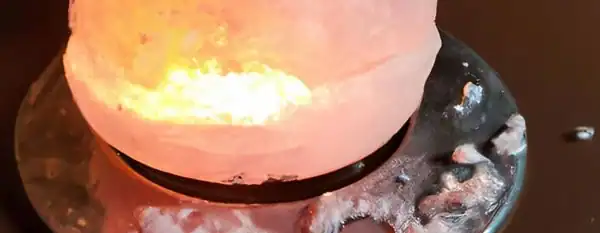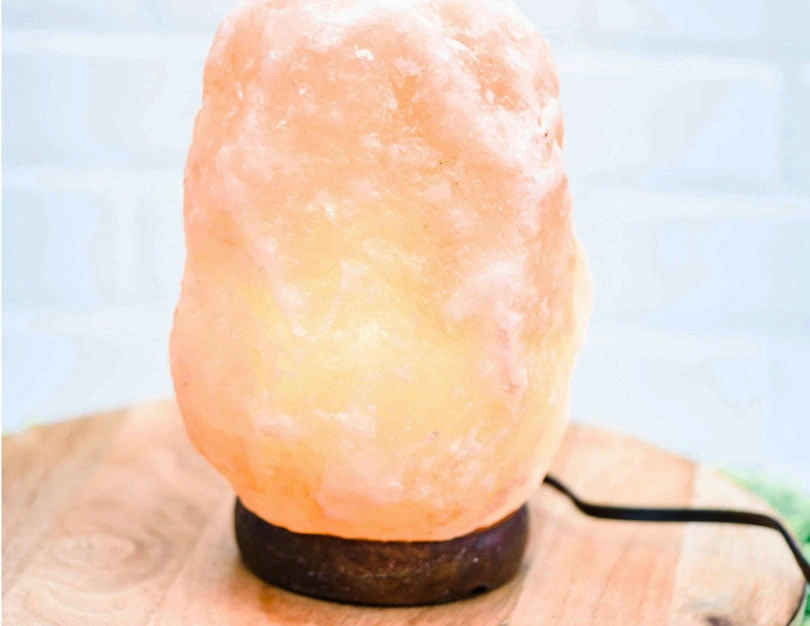Himalayan salt lamps have become increasingly popular in recent years due to their perceived health benefits and unique aesthetic appeal. These lamps are made from natural salt crystals that have been mined from the Himalayan mountains and are believed to release negative ions into the air when heated, which can help to purify the air and reduce stress.
However, one question that many people have is whether or not Himalayan salt lamps have a smell. Some people report that their lamps emit a subtle, relaxing aroma, while others say that their lamps have no scent at all. I explore this topic in-depth and answer some of the most common questions about Himalayan salt lamp odors.
Do Himalayan Salt Lamps Have a Smell?
Generally, Himalayan salt lamps do not have a significant smell since the salt used in these lamps is naturally odorless and does not release any fragrances on its own. However, the heat generated by the bulb inside can sometimes produce a slight smell as the plastic components warm up, especially when the lamp is new.
This faint plastic aroma is similar to “new car smell” and will usually fade in a short amount of time. This happens with most new plastic (think about new carpet!) and isn’t something that you generally need to worry about. If you notice a strong and persistent smell coming from your salt lamp, it may be due to the lamp being of low quality or counterfeit.
Authentic Himalayan salt lamps are made from pure Himalayan salt crystals, and they should not emit any unpleasant smells. To ensure that you are getting a high-quality lamp, it is essential to purchase from a reputable seller.

How Do I Tell a Real Salt Lamp from a Fake?
There are a number of ways to spot a Salt Lamp that isn’t real. Here are some things to look for in a authentic lamp:
- Heavy for it’s Size – Salt blocks are HEAVY. A 3″ diameter candle holder that fits in the palm of my hand weighs 1.5 pounds, so an average sized salt lamp (maybe 7″ x 10″) is going to weigh something like 15 pounds or more.
- Emits a Low Light – Salt lamps are not bright. They have a low wattage bulb trying to shine through semi-opaque salt. They tend to glow, not shine. If your lamp brightens the room, it is probably fake.
- Imperfections – Salt is a natural product. There will be natural color variations in the salt. There will be variations in transparency/opacity. If your lamp looks really uniform, especially when lit, it might be a fake.
- Made in Pakistan – Your lamp is far more likely to be the real deal if it is marked “Made in Pakistan”. Khewra Salt Mine in Pakistan’s Punjab province is the primary source for pink Himalayan salt. Frankly, much of the cost of producing and selling a salt lamp is the cost of shipping it, so it is not economically feasible to ship large quantities of salt to some other country to turn it into lamps. The rules of supply chain thus insure that salt lamps from some other country than Pakistan might be more likely to be a fake.
- It Dissolves – Real salt dissolves fairly easily, even when it is in a big crystalline block. Take a paper towel, get it wet and then squeeze it out. Wipe a section of your lamp and watch to see if the salt dissolves a bit. Bonus tip: If small flakes of salt can be shaved off of the surface, that’s another indication that the block is made from real salt.
- Tastes Like Salt – Yes I know. Elsewhere on this site I encourage people not to lick their salt lamps. Why You Shouldn’t Lick a Salt Lamp (Even if it’s Tempting). But a tiny taste might reassure you that your lamp is the real thing.
I hope these tips for spotting a real salt lamp vs fake salt lamp reassures you that your lamp is the real deal.
A Burning Smell Coming From My Salt Lamp
If you notice a burning smell coming from your salt lamp, it is important to take action immediately to ensure your safety and prevent damage to the lamp.
- Turn Off the Lamp – If you notice a burning smell coming from your salt lamp, the first thing you should do is turn it off immediately to prevent any potential fire hazards.
- Let the Lamp Cool Down – After turning off the lamp, allow it to cool down completely before handling it. Do not touch the lamp or cord while it is still hot.
- Check the Lamp and Cord – Inspect the lamp and cord to determine the source of the burning smell. Check for any visible damage or signs of overheating, such as melted plastic or discoloration. When electrical components burn, you can usually smell where the problem is by sniffing the lamp socket, the cord and the plug.
- Contact the Manufacturer – Contact the manufacturer or supplier for assistance. They may be able to offer guidance on how to safely use the lamp or provide a replacement if necessary. Frankly, if you actually smell burning electrical smell, your lamp cord and socket are probably “toast” (pun intended)
- Do Not Use the Lamp – Once you’ve smelled a burning smell from your lamp (or any electrical device, for that matter), DO NOT USE IT AGAIN. The salt block is okay though – and perhaps you can get a replacement lamp socket.
Salt itself does not really burn. The melting temperature of salt is 1474° F (801° C ). Since salt lamps usually have wooden bases, that’s the part you need to be careful about.
Can You Put Essential Oils On a Salt Lamp?
While you can put essential oils on a salt lamp, it’s important to do so with some caution since salt lamps are porous, meaning they can absorb and retain liquids, including essential oils. Over time these oils can corrode the salt, which could cause damage to the lamp.
It is important to note that not all essential oils are safe to use with salt lamps. Some oils, such as citrus oils, can cause the salt lamp to deteriorate over time. It is recommended to use high-quality, pure essential oils, and to avoid using too much oil as it can damage the lamp.
Additionally, it is crucial to regularly clean the salt lamp with a soft, damp cloth to prevent oil buildup and ensure the lamp’s longevity.
Step-by-Step Guide To Using Essential Oils With a Salt Lamp
Using essential oils with a Himalayan salt lamp can be a great way to promote relaxation and enhance the lamp’s benefits. Here is a step-by-step guide on how to safely use essential oils with your salt lamp:
- Choose Your Essential Oil – Select a high-quality, pure essential oil that is safe to use with salt lamps. Lavender, peppermint, and eucalyptus are popular choices due to their calming and refreshing properties.
- Apply the Essential Oil – Add one to two drops of the essential oil of your choice to the surface of the salt lamp. Finding a natural cavity or depression on your lamp’s surface is a good spot to apply the oil. Avoid adding too much oil, as this can damage the lamp and also create an overpowering scent in your room. If the essential oil doesn’t seem to be dispersing well, you can mix it with a bit of neutral oil like coconut oil or olive oil to help.
- Monitor the Lamp – While the lamp is on, monitor it to ensure that the scent is not too overpowering. If you find that the scent is too strong, turn off the lamp and let it cool down. You can also try using fewer drops of the essential oil or adding more salt to the lamp.
- Clean Your Lamp – After using essential oils with your salt lamp, it is important to clean the lamp regularly to prevent oil buildup. A cotton swab can be a useful tool to wipe out any excess oil. Occasionally, you might also want to use a soft, slightly damp cloth to wipe down the surface of the lamp.
By following these steps, you can safely and effectively use essential oils with your Himalayan salt lamp to create a calming and relaxing environment in your home or workspace.

Frequently Asked Questions about Himalayan Salt Lamp Odors
Can The Smell Of A Himalayan Salt Lamp Vary Depending on Size?
The smell of a Himalayan salt lamp might vary slightly depending on its size. Larger lamps tend to have a stronger scent than smaller lamps because they contain more salt. A larger lamp may also have room for a larger bulb, which in turn may have a higher wattage. More watts can warm up the salt more, making the salty smell a bit more pungent. For more about lamp sizes and corresponding weight, see Small To Large: The Perfect Himalayan Salt Lamp For Your Space.
Can The Smell Of a Himalayan Salt Lamp Vary Depending on Color?
Pink Himalayan salt gets it’s color primarily from Iron Oxide, so more intensely colored salt may have a slight odor that smells a bit like a clay pot – terra cotta clay pots also get their color from iron oxide. To learn more about the minerals in Himalayan salt, be sure to see Minerals In Himalayan Salt: Let’s See What’s In There.
How Long Can I Leave My Himalayan Salt Lamp On?
It is safe to leave your Himalayan salt lamp on for extended periods. However, it is important to take proper care of the lamp to ensure its longevity. Be sure to monitor the lamp and turn it off if it gets too hot or begins emitting an overwhelming scent. Additionally, it is important to dust and cleans the lamp regularly to prevent buildup and maintain its effectiveness. For tips regarding simple maintenance of a Salt lamp, see The Surprising Truth About Dirt on Himalayan Salt Lamps.
Table of Contents
Featured Image Photo credit: Hailey Moeller







